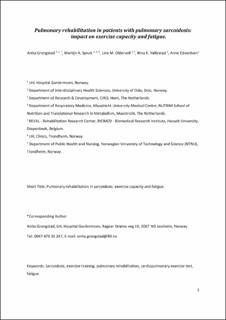Pulmonary Rehabilitation in Patients with Pulmonary Sarcoidosis: Impact on Exercise Capacity and Fatigue
Grongstad, Anita; Spruit, Martijn A.; Oldervoll, Line Merethe; Vøllestad, Nina Køpke; Edvardsen, Anne
Journal article, Peer reviewed
Akseptert

View/
Date
2020Metadata
Show full item recordCollections
Abstract
Background: There is limited evidence regarding the impact of multidisciplinary pulmonary rehabilitation (PR) on exercise capacity and fatigue in patients with pulmonary sarcoidosis. The aim of this study was to evaluate the impact on exercise capacity and fatigue following PR, and to examine whether baseline fatigue was related to change in peak oxygen uptake (ΔV̇O2peak). Methods: Forty-one patients with pulmonary sarcoidosis attending a 4-week inpatient PR program were recruited to this pre-post study. Both maximal exercise capacity, defined as V̇O2peak and measured with a cardiopulmonary exercise test, and fatigue, assessed with the Fatigue Assessment Scale (score 10–50 points), were measured before and after PR. Results: There was a statistically significant improvement in V̇O2peak (1.2 ± 2.3 mL/kg/min, p = 0.002), and fatigue decreased significantly (–1.7 ± 3.9 points, p = 0.009) following PR. Unadjusted linear regression analyses demonstrated that age (B = –0.076, p = 0.017) and baseline fatigue (B = 0.196, p = 0.001) were predictors for change in V̇O2peak, while in adjusted analyses (age, sex, baseline V̇O2peak, baseline fatigue, and diffusion capacity of the lung for carbon monoxide), only baseline fatigue predicted change in V̇O2peak following PR (B = 0.165, p = 0.026). Conclusion: A 4-week multidisciplinary PR program improves maximal exercise capacity and reduces fatigue in patients with pulmonary sarcoidosis. Baseline fatigue only partly predicted change in V̇O2peak following PR.